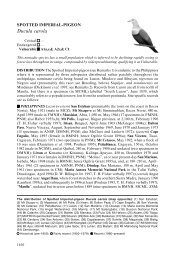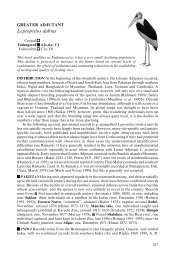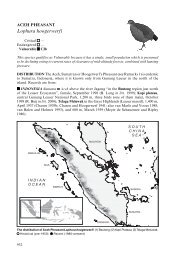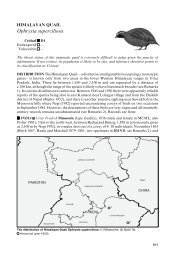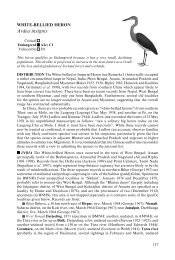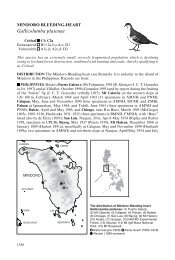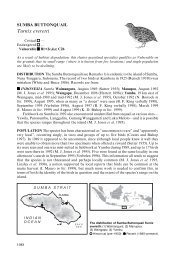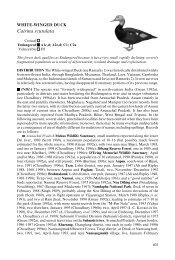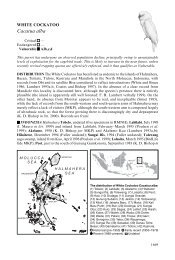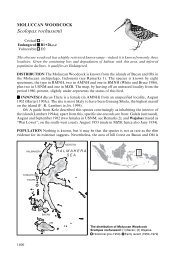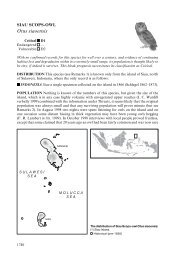Mycteria cinerea - BirdBase
Mycteria cinerea - BirdBase
Mycteria cinerea - BirdBase
Create successful ePaper yourself
Turn your PDF publications into a flip-book with our unique Google optimized e-Paper software.
Threatened birds of Asia<br />
containing Painted Stork, Lesser Adjutant and Spot-billed Pelicans Pelecanus philippensis<br />
(Mundkur et al. 1995a, Goes et al. 1998b).<br />
The major breeding colonies found in Sumatra in September 1988 were all in mangrove<br />
back swamps; at Tanjung Koyan the colony was some 2 km from the coast, in dense<br />
Acrostichum fern vegetation, with nests built in 3–4 m high bushes around a small (900 m²)<br />
pool; at Tanjung Selokan it was 1–2 km from the coast, with nests 5–15 m up in 10–12 dead<br />
trees within a flooded area 15 ha in extent; on the Banyuasin peninsula it was 3–4 km inland,<br />
2–6 m up in 10–15 small bushes near a 2,500 m² pool in dense Acrostichum fern vegetation<br />
(Danielsen et al. 1991a); and at Kuala Betara, it was situated in the outer mangrove fringe in<br />
nine trees (probably Avicennia, although some were later identified as “red mangrove”<br />
Rhizophora apiculata) 8–12 m high (Danielsen and Skov 1985, 1987; also Silvius 1988). Two<br />
other nesting colonies were also reported one and three hours inland by canoe (Danielsen<br />
and Skov 1985). On Java a colony of 75–100 nests was sited in a group of large “black<br />
mangrove” Avicennia marina covering c.4.5 ha; nest-trees generally held 5–7 nests, sometimes<br />
10, rarely only 2–3 (Hoogerwerf 1936a). At the Citarum delta only very tall trees were used,<br />
one of these containing 22 nests (Bartels 1915–1930). In the same tree species, nests were<br />
placed at heights of 8–30 m (Verheugt 1987), usually 30 m up on Pulau Rambut, but originally<br />
(prior to disturbance) down to 4 m above the ground on Pulau Dua (Hancock et al. 1992). In<br />
Malaysia, a colony of 20 nests was situated 8–10 m up both live and dead trees, mostly the<br />
latter (Siti Hawa Yatim 1990); in another case two nests were placed in the tops of mangroves<br />
(Robinson and Chasen 1936). Nests are fairly bulky structures of sticks, lined with fresh<br />
leafy twigs, in general resembling the nests of Grey Herons Ardea <strong>cinerea</strong> but containing<br />
thicker branches (Hoogerwerf 1936a, Robinson and Chasen 1936). Twigs and fresh leaves<br />
are sometimes collected for the nest from some distance away (Bartels 1915–1930).<br />
Clutch, incubation and fledging Nine clutches from Java consisted of three eggs (Hellebrekers<br />
and Hoogerwerf 1967), although nests in one large colony held mostly two young, one with<br />
one and a few with three (Hoogerwerf 1936a), and clutches of four eggs have been recorded<br />
(Hoogerwerf 1949). In 1984, nests at Pulau Rambut, Java, mostly contained two young<br />
(Verheugt 1987). Two nests in Malaysia both contained three young (Robinson and Chasen<br />
1936). The incubation period is estimated at 27–30 days; by 6–7 weeks the young are able to<br />
leave the nest and fly poorly, and by eight weeks they fly well but are still fed in the nest by<br />
parents (Hoogerwerf 1936b). Small young are fed more frequently than large young; before<br />
they are four weeks old chicks may be fed twice per hour (presumably on small items), whereas<br />
older nestlings may only be fed once per afternoon (presumably on larger items) (Hoogerwerf<br />
1936b). When temperatures are high, adults sometimes bring water to the nest and drool it<br />
from their bills to cool the nestlings or allow them to drink (Hancock et al. 1992).<br />
Migration Most waterbirds breeding around Tonle Sap vacate the area during the wet<br />
season, visiting wetlands across Cambodia (C. M. Poole in litt. 1998, Goes 1999a). The recent<br />
sighting of birds in the Gulf of Thailand coincides with this annual wet-season exodus<br />
(C. M. Poole verbally 1999), and indeed the species may be an overlooked regular but rare<br />
visitor to the area (P. D. Round in litt. 1999).<br />
In Peninsular Malaysia the Perak population is essentially resident (Wells 1999). The few<br />
sightings from Johor are probably occasional wanderers from the Riau and Jambi populations<br />
on Sumatra, only 70 km distant (Hawkins and Howes 1986; see Remarks 1). The record<br />
from north-west Bali in October 1982 was of a bird flying east during a raptor migration<br />
(Ash 1982, NJC), and other sightings to the east in Sumbawa suggest that individuals<br />
occasionally wander for great distances. In addition, two birds were observed crossing the<br />
Sunda Straits in September 1984 (Allport and Wilson 1986), a flock of presumed immigrants<br />
was seen flying east at Serang, West Java, again in September 1984, and spring migration<br />
was noted in April 1985 when two small groups were seen flying in a north-westerly direction,<br />
leaving mainland Java and travelling towards Sumatra (Verheugt 1987). Although such<br />
176



